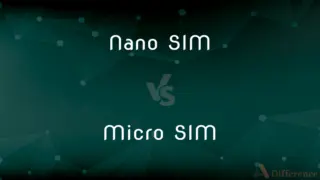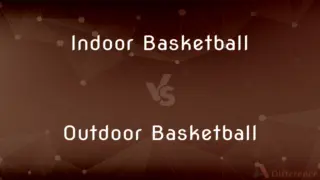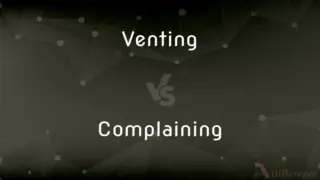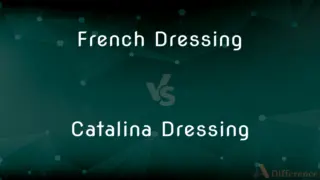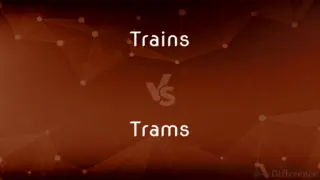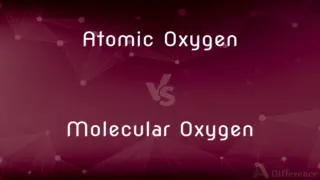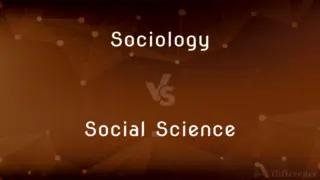Andante vs. Allegro — What's the Difference?
By Tayyaba Rehman & Fiza Rafique — Updated on March 17, 2024
Andante signifies a moderate walking pace in music, while Allegro denotes a fast, lively tempo.

Difference Between Andante and Allegro
Table of Contents
ADVERTISEMENT
Key Differences
Andante is a musical term that describes a tempo marking, suggesting that the music should be played at a moderate, comfortable pace, akin to a leisurely walk. It typically falls within the range of 76 to 108 beats per minute (BPM), providing a relaxed, flowing rhythm that allows for expressive detail and lyrical phrasing in the music. Allegro, on the other hand, is used to indicate a quicker tempo, suggesting that the piece should be played in a fast, lively, and spirited manner. The BPM for allegro often ranges from 120 to 168, giving the music an upbeat and energetic feel.
The mood and character conveyed by andante pieces tend to be calm, reflective, and often introspective, allowing listeners to savor the melodies and harmonies. It's commonly used in sections of larger works to provide contrast with faster movements, offering a moment of repose and emotional depth. Allegro pieces are characterized by their brightness, vigor, and often joyous nature, driving the music forward with momentum and excitement. This tempo is frequently employed in opening movements of symphonies and sonatas to capture the listener's attention and set an energetic tone.
In terms of performance, andante tempos allow musicians more space for expressive phrasing and dynamic nuance, giving them the opportunity to explore the emotional subtleties within the music. The moderate pace provides a certain clarity to each note and phrase, making it ideal for pieces that require a high level of expression. Allegro tempos, however, demand precise technical skills and a high level of energy from performers, as the rapid pace leaves less room for error and requires tight coordination, especially in ensemble settings.
Compositionally, andante passages often feature more lyrical melodies and a greater focus on harmonic development, as the moderate tempo allows these elements to be more fully realized and appreciated. In contrast, allegro sections might prioritize rhythmic drive and thematic development, with composers using faster tempos to build tension, excitement, or convey a sense of motion and activity.
The choice between andante and allegro tempos can significantly affect the overall structure and emotional journey of a musical piece. Composers often use these contrasting tempos to create a dynamic and varied listening experience, moving the listener through different moods and intensities. The transition from an andante to an allegro section within a piece can dramatically shift the music's direction, offering a refreshing change of pace and energy.
ADVERTISEMENT
Comparison Chart
Tempo Range
76-108 BPM
120-168 BPM
Mood/Character
Calm, reflective, introspective
Bright, vigorous, joyous
Performance Focus
Expressive phrasing, dynamic nuance
Technical precision, energy
Compositional Features
Lyrical melodies, harmonic development
Rhythmic drive, thematic development
Effect on Structure
Provides contrast, emotional depth in works
Drives momentum, sets energetic tone
Compare with Definitions
Andante
Moderately slow tempo, suggesting a walking pace.
The andante movement in the concerto allowed for expressive solos.
Allegro
Fast and lively tempo in music.
The symphony kicked off with an allegro movement, full of energy.
Andante
Referring to a moderate pace in the context of musical performance.
The quartet maintained an andante pace, emphasizing the harmonic intricacies.
Allegro
Conveying a sense of joy and brightness in musical compositions.
The allegro passage injected a burst of joy into the performance.
Andante
Used in music to indicate a specific tempo marking.
The piece began with an andante tempo, setting a serene atmosphere.
Allegro
Used to describe music that emphasizes rhythmic drive.
The allegro rhythm propelled the piece forward with unstoppable momentum.
Andante
In terms of mood, often conveying calmness and thoughtfulness.
The andante section brought a reflective pause to the lively symphony.
Allegro
Pertaining to a rapid and spirited performance style.
The pianist's allegro interpretation was both precise and spirited.
Andante
Associated with music that allows for lyrical expression.
The andante melody was rich with emotional expression.
Allegro
A tempo marking indicating quickness and lightness.
The score marked the next section as allegro, signaling a swift pace.
Andante
In a moderately slow tempo, usually considered to be slower than allegretto but faster than adagio. Used chiefly as a direction.
Allegro
In a quick, lively tempo, usually considered to be faster than allegretto but slower than presto. Used chiefly as a direction.
Andante
An andante passage or movement.
Allegro
An allegro passage or movement.
Andante
(music) A tempo mark directing that a passage is to be played in a moderately slow tempo; faster than adagio but slower than moderato.
Allegro
A succession of fast jumps performed as an exercise in ballet.
Andante
(music) A passage having this mark.
Allegro
(music) A tempo mark directing that a passage is to be played in a quick, lively tempo, faster than allegretto but slower than presto.
Andante
(music) Played at a moderately slow tempo.
Allegro
An expressive mark indicating that a passage is to be played in a lively or happy manner, not necessarily quickly.
Andante
(music) Describing a passage having this mark.
Allegro
(music) A passage having this mark.
Andante
Moving moderately slow, but distinct and flowing; quicker than larghetto, and slower than allegretto.
Allegro
(music) played in a quick, lively tempo
Andante
A moderately slow tempo (a walking pace)
Allegro
(music) in a quick and lively manner
Andante
(of tempo) moderately slow
Allegro
Brisk, lively.
Andante
At a moderately slow temp;
This passage must be played andante
Allegro
A brisk and lively tempo
Allegro
A musical composition or passage performed quickly in a brisk lively manner
Allegro
(of tempo) fast
Allegro
In a quick and lively tempo;
Play this section allegro
Common Curiosities
Do andante and allegro tempos affect the emotional impact of a piece?
Absolutely, the tempo can significantly influence the mood and emotional response of the listener, with andante sections often providing calmness and allegro sections bringing excitement.
Can a piece of music contain both andante and allegro sections?
Yes, many compositions, especially in classical music, feature a variety of tempos, including both andante and allegro, to create contrast and interest.
Are andante and allegro exclusive to classical music?
While these terms originate from classical music, they are used across various genres to describe tempo and mood.
How do composers decide between using an andante or an allegro tempo?
Composers choose tempos based on the emotional and structural needs of the piece, using different tempos to highlight contrasts, build tension, or develop themes.
How do ensemble musicians maintain cohesion during rapid allegro sections?
Ensemble cohesion in allegro sections is achieved through meticulous rehearsal, clear conducting, and attentive listening among musicians to maintain precise rhythm and unity.
Is it possible for a piece to transition directly from andante to allegro?
Yes, composers often use direct transitions from andante to allegro to create dramatic shifts in energy and mood within a composition.
How does a musician know when to play andante or allegro?
Musicians rely on tempo markings provided in the music score and the conductor's or performer's interpretation to determine the appropriate pace.
Do andante sections require less technical skill than allegro sections?
Not necessarily; andante sections, while slower, demand high levels of control, expression, and phrasing, which can be technically and emotionally challenging.
Are there musical genres that predominantly use andante or allegro tempos?
Certain genres may favor specific tempos due to their stylistic characteristics; for example, ballads often employ andante tempos, while many dance music genres lean towards allegro tempos.
How does the choice of instruments affect the execution of andante and allegro tempos?
The timbre and technical capabilities of different instruments can influence how andante and allegro passages are executed, with some instruments better suited to sustained lyrical lines and others to rapid, agile passages.
Can the andante and allegro tempos be subjective to the performer's interpretation?
Absolutely, performers may interpret tempo markings with some flexibility, bringing their own expressive insight to the music within the composer's intended tempo range.
What historical developments have influenced the use of andante and allegro tempos in music?
Historical factors, including the evolution of musical styles, performance practices, and the development of metronomes, have shaped how andante and allegro tempos are defined and used in music.
Can andante and allegro tempos be combined within the same musical phrase?
While uncommon, skilled composers and arrangers can creatively blend andante and allegro elements within a single phrase for unique expressive effects.
How do andante and allegro tempos influence the physical movements of a conductor?
A conductor's gestures become broader and more fluid in andante sections to convey the tempo and expressive qualities, while allegro sections often require more precise and energetic movements to maintain the faster pace.
In music education, how are andante and allegro tempos introduced to students?
Students typically learn to distinguish and perform various tempos through guided practice, using metronomes for accuracy, and studying diverse repertoire that incorporates different tempos.
Share Your Discovery

Previous Comparison
Sabotage vs. Espionage
Next Comparison
Courteous vs. KindAuthor Spotlight
Written by
Tayyaba RehmanTayyaba Rehman is a distinguished writer, currently serving as a primary contributor to askdifference.com. As a researcher in semantics and etymology, Tayyaba's passion for the complexity of languages and their distinctions has found a perfect home on the platform. Tayyaba delves into the intricacies of language, distinguishing between commonly confused words and phrases, thereby providing clarity for readers worldwide.
Co-written by
Fiza RafiqueFiza Rafique is a skilled content writer at AskDifference.com, where she meticulously refines and enhances written pieces. Drawing from her vast editorial expertise, Fiza ensures clarity, accuracy, and precision in every article. Passionate about language, she continually seeks to elevate the quality of content for readers worldwide.















